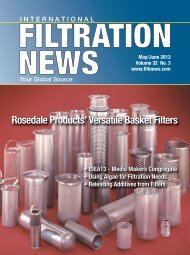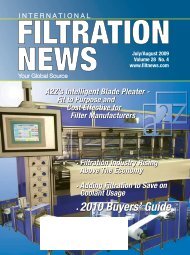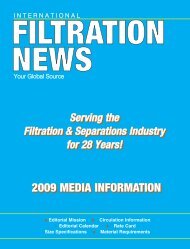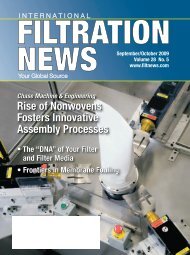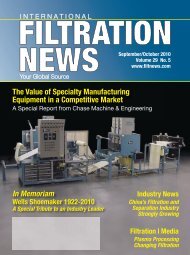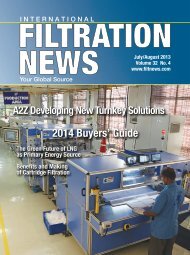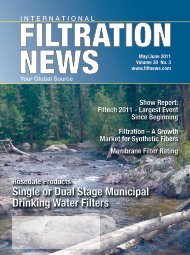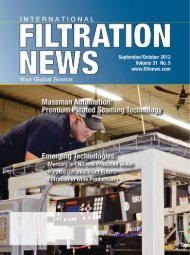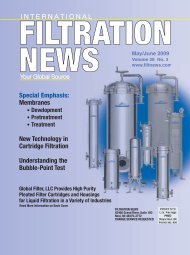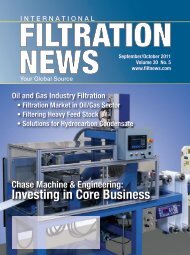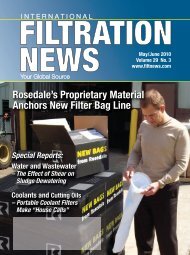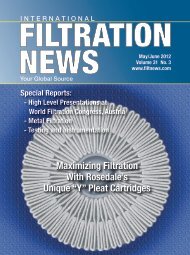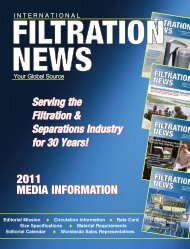2011 Buyers' Guide 2011 Buyers' Guide - International Fiber Journal
2011 Buyers' Guide 2011 Buyers' Guide - International Fiber Journal
2011 Buyers' Guide 2011 Buyers' Guide - International Fiber Journal
- No tags were found...
Create successful ePaper yourself
Turn your PDF publications into a flip-book with our unique Google optimized e-Paper software.
sterilizing grade 0.2 µm or 0.22 µm ratedfilters (0.2 and 0.22 are used interchangeablydepending on the manufacturer) isthe complete retention of Brevundimonasdiminuta ATCC #19146 at a concentrationof at least 1.0 x 107 organisms persquare centimeter (CFU/cm 2 ) of effectivefiltration area (EFA) using “worst case”processing conditions. Smaller pored filtersor filtering in series (a process commonin Europe) may also be employed toachieve complete retention.As the mechanism of retention inmembrane filters is not a sieving function,the chemical and physical propertiesof the product can have asignificant influence on the effectivenessof the filter. It is therefore essentialthat the product’s effect on theretention function is evaluated beforetraditional challenge testing. Filtercompatibility studies are required andthe chemical and physical propertiesof the product are evaluated prior todesign of the validation protocol.VALIDATING STERILE FILTRATIONThe Parenteral Drug Association(PDA) suggests in Technical Report 26that the user evaluate four different aspectsof their filtration process in orderto validate sterile filtration: Extractables/Leachables,Compatibility, Integritytesting, and Microbial Retention.Extractables/leachables: The PDATechnical Report 26 defines an extractableas “any chemical componentthat is removed from a material by theapplication of an artificial or exaggeratedforce” and a leachable as “a chemicalcomponent that migrates from acontact surface into a drug product orprocess fluid during storage or normaluse conditions.” During filtration, theprocess fluid is exposed to many componentssuch as the filter membrane,housing, o-rings, piping, etc., all ofwhich can contribute to extractablesentering the final product. It is essentialin the validation to determine theamount of extractables that mightenter the fluid stream. There are manyways to determine this, the most commonbeing the measurements of nonvolatileresidues. Other methodsinclude measuring total organic carbons(TOC), Fourier transform infraredspectroscopy (FTIR), gaschromatography with mass spectroscopy(GC-MS), etc. Since the drugproduct may interfere with many ofthese tests, it is common to perform anextraction using a surrogate solution.The extraction can be performed usingstatic (soaking) or dynamic (movementof fluid through the filter) conditionswith special consideration forthe sterilization process, flushing procedures,contact time, temperaturesand chemical attributes of both thesystem and the process fluid.Compatibility: Testing for compatibilitycan be performed as a separatepart of the validation or as part of themicrobial retention. Validating thecompatibility of the filter and the entiresystem including hoses, o-rings,pumps, housings, core, etc., ensure thatthey can withstand the worst-case conditionsof the sterilization and productionprocesses. Compatibility tests caninclude integrity tests, evaluation ofBack Your Filters BetterExtensive Range of Expanded Metals & Polymers Perfect for membrane support & backing Assures media integrity & pleatspacing even under dynamic flow Materials laminate for co-expansion/contraction/flex Openings down to25 micron Thickness: 0.001”to 0.2”Dexmet Engineerswelcome the challengeof your unique materialsand applicationsCustom-ExpandedMaterials from203 294 4440 www.dexmetfilter.comwww.filtnews.com • August 2010 • 15



